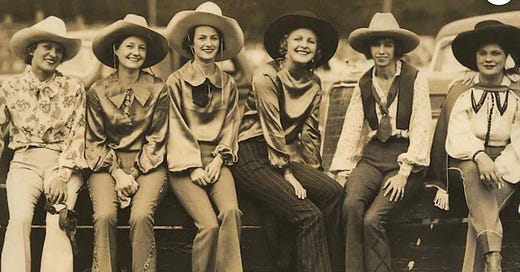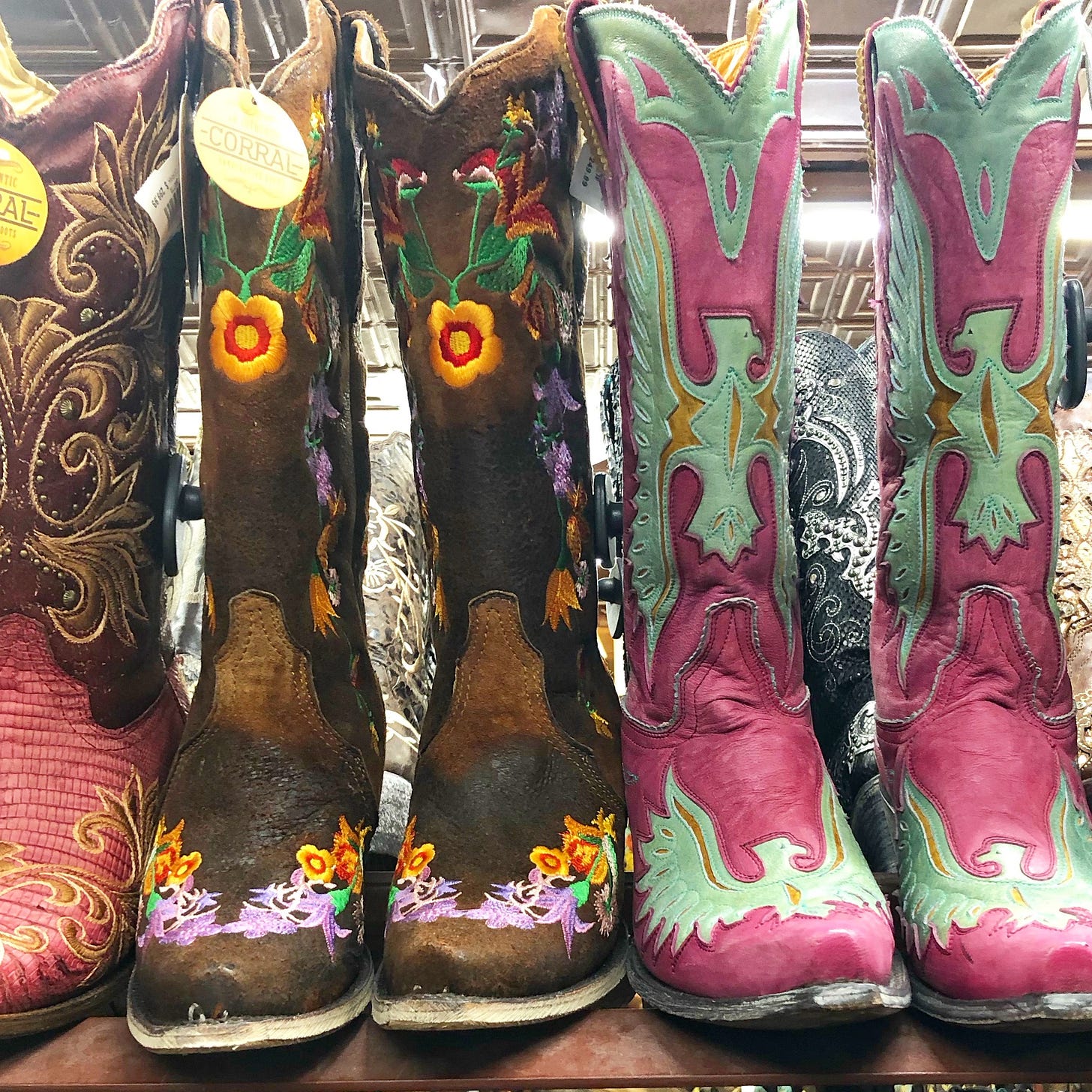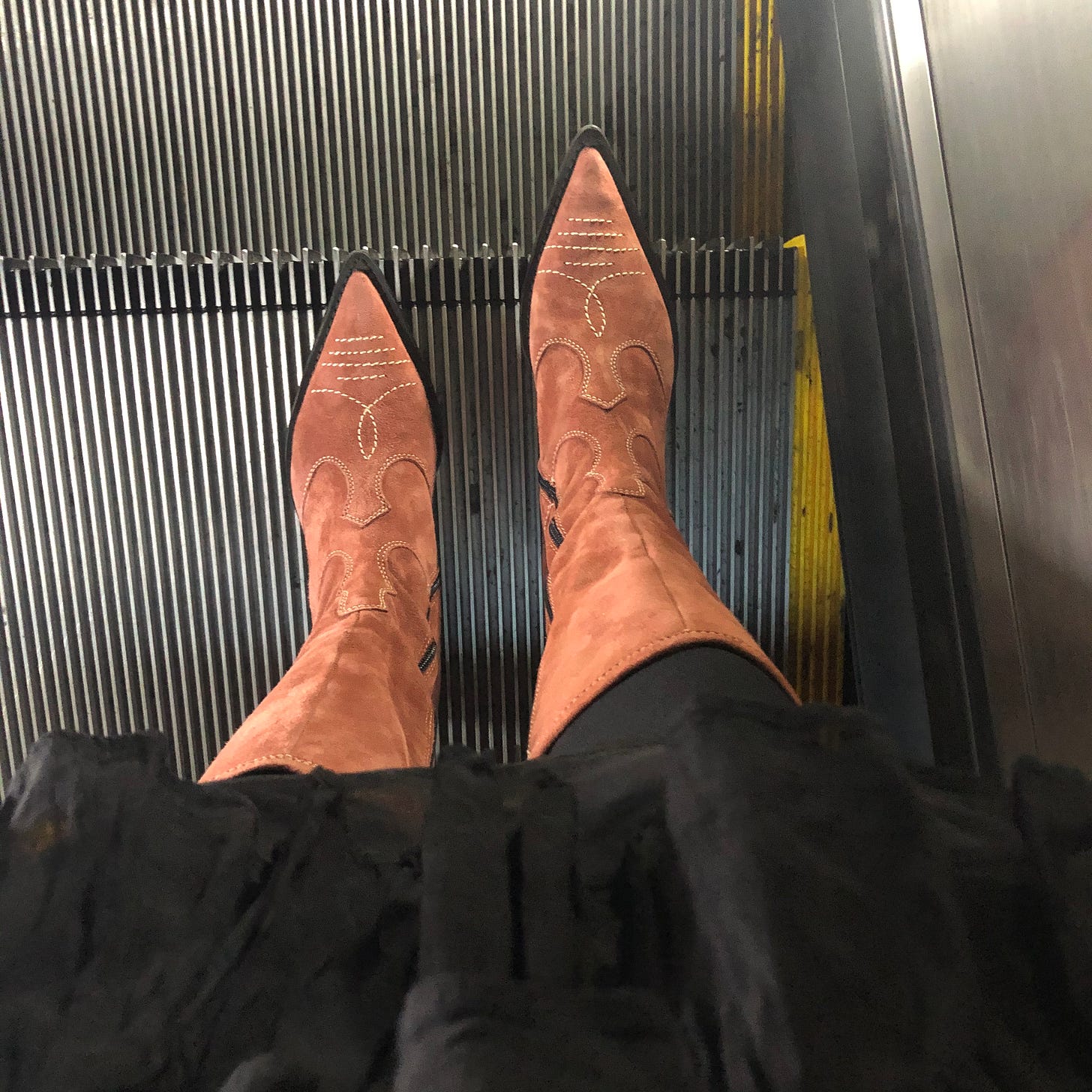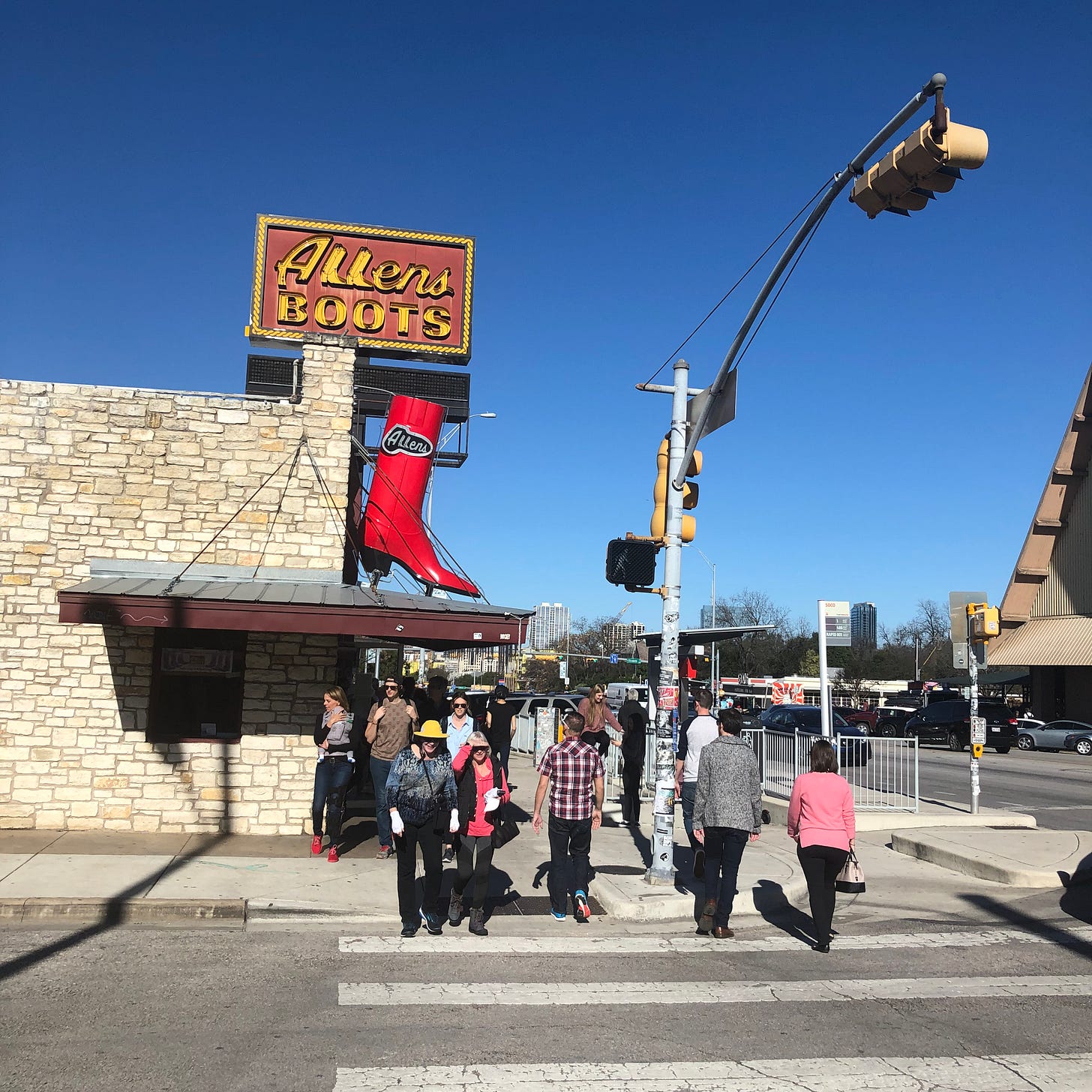25: A cowboy boot road map
I shunned Western footwear as a Texas kid. Now I score boots everywhere from San Antonio to Santa Fe.
“How come your daddy’s got no boots?”
That question, one part insult, two parts bewilderment, came from my third-grade crush Jeff P. Jeff and I were awaiting parental pick-ups in the shade of a scraggly oak tree outside of our San Antonio, Texas elementary school. He wore kid-sized western boots and had ragtag blond hair that kept flopping in his eyes as he hit me in the arm with his Dukes of Hazzard lunchbox. I was smitten.
As my father walked up to get me, Jeff stopped whacking me and gawped. Dad, in loafers and a tweed blazer, looked like what he was—a liberal-arts professor transplanted from Chicago. He didn’t, like so many other Texas fathers, wear round-toed Roper boots with his jeans or pointy-toed boots with his suits.
As Dad bundled me into our mustard yellow station wagon, I wondered aloud, “How come you don’t buy some boots?” Dad side-eyed me and muttered, “I don’t ride in the rodeo, and I don’t work at a ranch.”
He had never slid his skinny feet into Luccheses, Tony Lamas, or other boots with Lone Star State pedigrees. But cowboy footwear was (and still is) everywhere in South Texas. At my high school, “kicker” kids paired boots with “stacked” Wranglers (aka longer denim that wrinkles around the ankle). In college, George Strait lookalikes wore snub-toed Justin ropers to waltz around Gruene Hall, the 1878 dance spot between San Antonio and Austin.
Two-stepping into my own cowboy boots
By college in the 1980s, I had succumbed to the honky-tonk spell of cowboy boots, scoring scuffed black Luccheses at an Austin thrift store. My Ozarks-born mother was aghast. “You aren’t a honky-tonk singer, Jennifer Nell!”
But I wore those boots everywhere. With high-waisted, acid-washed jeans, they went dancing at the Gruene; under straight, thigh-clutching 1980s miniskirts, two-stepping was impossible, but slam dancing to R.E.M. was not.
I’m not a native Texan; I moved with my family to San Antonio as a toddler. But those Luchheses transformed me into a hometown cowgirl, albeit one more likely to wear them with a grunge-era flannel dress than a spangled western hat.
When I shimmy into boots, I feel formidable, a Southwestern superhero who can bargain for turquoise in Arizona or stomp through London art galleries. (For the latter, I’d wear boots under tweed, wide-leg pants for a Harry Potter-meets-Yellowstone vibe.) “There’s such an outlaw quality to cowboy boots, which helps you be very inventive with how you wear them,” says Jennifer June, an Austin bootmaker and author of Cowboy Boots: The Art & Sole.

“I’m constantly experimenting with my boots,” says Lizzy Chestnut Bentley, the founder of CITY Boots, a high-end brand with stores in Fort Worth, Austin, and Houston. “I love pairing mine with long flowing skirts or dresses for a feminine vibe. With a mini skirt and a blazer, they look really modern and powerful.”
Cowboy boots go on my feet (not in the suitcase) for trips back to Texas or to Santa Fe, where my husband and I dream of moving. I’ve shopped for them from Texas to Nevada and beyond, picking up vintage pink suede kicks at Junkee in Reno, basic tobacco brown knee highs from Tecovas in Austin, and vintage snakeskin boots, which cost just $25 at the Georgetown Flea Market in Washington, D.C. They’re under my sleek Cos shirtdresses for dinners out, and for the airplane, I layer them under Donni’s knit kick-flair pants.
I’m not sure what my Dad, or Jeff, would think. But years after I moved away from Texas, my footwear remains rooted in the Lone Star State.
Here’s more on where cowboy boots came from and a resource guide to buying them new. Next week’s newsletter will cover vintage and custom boot sources.
A short history of tall boots
Though humans on horseback have donned boots for millennia (hey, Gingis Khan!), the cowboy boot first toed into style in late 19th-century America. “They have their roots in the boots Spanish settlers wore, but rich ranchers and even rodeo riders put them on both for work and because they wanted to stand out,” says fashion historian Sonya Abrego, author of Westernwear: Postwar American Fashion and Culture. Western movies and TV shows of the mid 20th century left a fashion bootprint, too.
Cowboy boots are purpose-driven: tall shanks to protect your calves on long cattle drives; angled, chunky heels for edging your horse onward, pointed toes to make it easier to stick your foot into the stirrups. But their fanciful embellishments made them popular both on and off the range. Think tooled leather, metallic inlays, and curlicued, stitched “toe bugs,” which decorate boot tops and keep them from wrinkling.
Boots can be both for a place (honky-tonk dance halls, Paris streets) and of it. Custom bootmakers such as San Antonio’s Little’s Boot Company and El Paso’s Rocketbuster sew pairs emblazoned with maps and symbols of New York City (yellow taxis, the Statue of Liberty), Texas (knee-to-toe bluebonnets) and Italy (Rome’s colosseum in silver leather). “Cowboy boots are an American art form and a way we tell stories,” says June.
Whether you’re buying vintage, custom or premade boots from “rack” brands (Lucchese, Tecovas), the construction is similar. A sturdy leather sole is attached to the boot’s uppers via wooden pegs and stitching. Heels are formed of stacked wood, usually about an inch to 1.5 inches high. It all adds up to a shockingly comfortable boot, as suited for sliding around a sawdust Texas dance floor as strolling around a foreign city.
My favorite ready-made boot brands
There are three ways to buy cowboy boots: ready-made (or off the rack), custom, and vintage. Next week, this newsletter will talk about vintage and custom options. This week, here’s a list of my top spots for new boots. Expect to pay anywhere from about $200 to $1,000 and up a pair.
Allens Boots: Austin, Texas: The smell of leather greets you at this longtime South Congress Street boot emporium, which stocks its own line as well as brands like Azulado.
CITY Boots: Austin, Houston, Fort Worth. Lizzy Chestnut Bentley founded this women’s footwear brand in 2015, because she “felt there was a void in the market for a modern, feminine boot for the city girl, or let’s say, the urban cowgirl.” High-end, well-made styles come in girly colors (lavender, pink) embellished with hearts, evil eyes, and other designs.
Fraulein Boots: Two San Antonio sisters decorate their luxe boots with roadrunners, cacti, and other Western symbols in bright hues. Buy them online or at several boutiques in the Southwest.

Justin: Founded in 1879, this Texas brand (and sibling Nocona and Tony Lama) cater to working ranchers and rodeo riders as well as weekend cowpokes with women’s, men’s, and kid’s styles. Lama excels at exotic leathers like striated caiman.
Lucchese: 28 stores across the U.S. Founded in San Antonio by Italian immigrant brothers in 1883, this high-end brand offers men’s and women’s boots in leather and exotics (ostrich, lizard). Urbane cowgirls come in for the popular, knee-grazing Priscilla (around $1,000), which looks hip with shorter dresses.
Old Gringo: Fort Worth: Want boots in fiesta-bright colors or decked with flowers and Day of the Dead skulls? Find them and other Mexican-made styles at the Fort Worth Stockyards HQ of this long-running brand, which also sells online and through multiple retailers. OGs scream Coachella or Jason Isbell concert.
Tecovas: dozens of U.S. stores. Tecovas puts out mid-priced ($250-$700) boots for men and women and operates down-home boutiques where customers sip bourbon while they shop. The brand frequently uses goat leather, which is rich in oils that keep boots supple. Standout styles: Ropers for him, booties for her.












Despite the fact that my maternal grandfather raised beef cattle and I gres up in Montana, I got my first pair of cowboy boots when I was 18. My then-boyfriend's father bought them for me along with a cowboy hat, appropriate pants and shirt so I could represent his ranch in a Dude Ranch Queen Contest during the local rodeo. He also let me ride a wonderful horse who knew all about prancing down a street in a parade as well as how to run a barrel race. (I didn't win the queenship, but I did not disgrace Karst's Ranch.) I didn't wear my boots as a college student but as a young bride feeling very much out of my element in Boston, I put them on one night to stomp around Beacon Hill to demonstrate that I didn't care if I was a hick from the sticks. Years later, after I joined the foreign service and again felt a little out of my element, I took pleasure in stomping around the basement at the State Department in my cowboy boots when I went across the river from where I was learning Thai language. Hmmm. I'm thinking maybe it's time to invest in a new pair to express my feelings about this whole becoming elderly business!
Great piece!